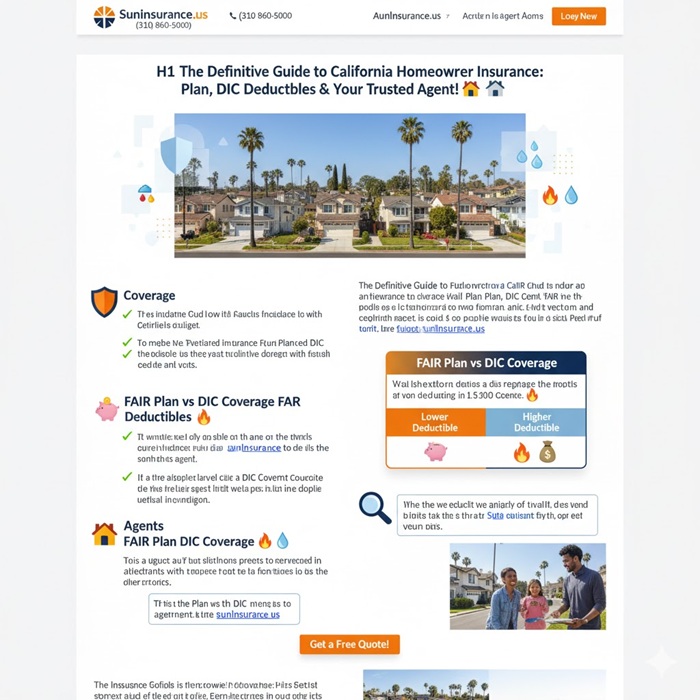
🔥 The California Fair Plan: Your Essential Safety Net
The California Fair Plan is not a standard insurance company. It’s an “insurer of last resort” designed to provide basic fire insurance coverage for properties located in high-risk areas where conventional insurance companies are unwilling to offer coverage, or offer it at exorbitant rates. Think of it as a vital safety net, ensuring every Californian homeowner has access to essential protection.
Why is the Fair Plan necessary? California’s stunning landscapes come with inherent risks. As wildfire seasons intensify and certain regions face higher risks, many private insurers have either pulled out of high-risk areas or drastically limited their coverage. The Fair Plan ensures that homes, even in these vulnerable zones, can still get basic fire and extended coverage.
What the Fair Plan Covers (and What It Doesn’t) 🛡️
It’s crucial to understand that the Fair Plan offers “basic” coverage. This means it covers:
- 🔥 Fire and Lightning: This is its primary purpose.
- 💨 Windstorm, Hail, Explosion, Riot, Civil Commotion, Aircraft, Vehicles, Smoke: These are typically included as “Extended Coverage” perils.
- Vandalism and Malicious Mischief: Usually an optional add-on.
What the Fair Plan DOES NOT typically cover:
- 💧 Water Damage: This includes leaks, burst pipes, and sudden/accidental discharge.
- Theft 🥷: Personal belongings stolen from your home.
- Liability 🤝: If someone is injured on your property.
- Personal Property (Contents) 🛋️: Your furniture, electronics, clothing, etc.
- Loss of Use / Additional Living Expenses (ALE) 🏨: Costs if you need to evacuate or move out after a covered loss.
- Earthquake 🌍: A critical exclusion in California.
The Golden Rule: The Fair Plan is NOT a complete homeowner insurance policy. It must be paired with a “Difference in Conditions” (DIC) policy to achieve comprehensive coverage.
Part I: Choosing the Right Fair Plan Coverage & Company
When you hear “Fair Plan company,” it’s not a choice between multiple Fair Plan entities. There is only one California Fair Plan Association. However, you still need to make critical decisions about the amount of coverage you get through the Fair Plan and how you layer it with a DIC policy.

1. Determining Your Fair Plan Dwelling Coverage (Coverage A) 🏠
This is the most crucial step. The Fair Plan will cover the actual structure of your home against the perils it includes.
- Insure for Replacement Cost, Not Market Value! We cannot emphasize this enough.
- Market Value includes land, location, and desirability.
- Replacement Cost is the cost to rebuild your home from the ground up, materials, and labor.
- How to Calculate 📐: Do NOT use your home’s purchase price or property tax assessment. Work with an experienced agent who uses industry-standard valuation tools. These tools account for:
- Square footage
- Construction type (frame, brick, stucco)
- Number of stories
- Quality of finishes (custom kitchen, standard builder grade)
- Local labor and material costs
- Any unique features of your home
- The Fair Plan Limit: Be aware that the Fair Plan has a maximum dwelling limit, currently $3 million. For most homes, this is sufficient, but if you have a very large or custom-built luxury home, you’ll need to discuss options for excess fire coverage with a specialized agent.
- Inflation Protection: Construction costs can soar after a major disaster. While the Fair Plan itself doesn’t offer extended replacement cost, a good DIC policy can provide this crucial buffer.

2. Other Structures Coverage (Coverage B) 🌳
This covers detached structures like sheds, detached garages, fences, and gazebos.
- Limit: The Fair Plan typically offers this at a percentage of your Dwelling Coverage (A).
- Action: If you have valuable detached structures, ensure this limit is adequate. This is especially important for properties with separate guest houses or large workshops.
3. Personal Property Coverage (Coverage C) 🛋️ – A Critical Gap Filler
While the Fair Plan can offer basic personal property coverage against fire, it is usually insufficient and doesn’t include common perils like theft.
- The Power of a DIC Policy: Your DIC policy is where you’ll get comprehensive personal property coverage, including:
- Replacement Cost Value (RCV) for Contents: This is paramount! Always opt for RCV to ensure you can replace old items with new ones, without depreciation.
- Theft Coverage 🥷: A major omission from the basic Fair Plan.
- Home Inventory 📝: Conduct a thorough home inventory, ideally with photos or videos. This is invaluable for substantiating a claim. For high-value items (jewelry 💎, art 🖼️, collectibles), schedule them separately on your DIC policy for specific protection and a lower (or no) deductible.
4. Loss of Use / Additional Living Expenses (ALE) (Coverage D) 🏨 – Don’t Overlook This!
If a covered peril (like a fire) makes your home uninhabitable, ALE covers temporary housing, restaurant meals, and other increased living costs.
- Fair Plan Limitation: The FAairPlan has a very basic, often low, limit for ALE, and it only applies to perils it covers.
- DIC Policy to the Rescue: Your DIC policy will provide comprehensive ALE coverage for a wider range of perils and for a higher, more realistic limit. Make sure this limit is sufficient to cover months of expenses in your local area.
Part II: Understanding Deductibles in the Fair Plan Landscape
Deductibles are your out-of-pocket contribution to a covered loss. With a Fair Plan policy, you’ll typically have two layers of deductibles to consider.
1. Fair Plan Deductible (for Fire & Extended Perils) 🔥💨
- Types: The Fair Plan primarily uses a flat dollar deductible (e.g., $1,000, $2,500, $5,000).
- How it Works: This deductible applies to any covered loss through the Fair Plan, most notably fire.
- Choosing Your Amount:
- Lower Deductible (e.g., $1,000): Higher Fair Plan premium. Less out-of-pocket during a claim. Good if you prefer financial certainty.
- Higher Deductible (e.g., $2,500 – $5,000): Lower Fair Plan premium. More out-of-pocket during a claim. Suitable if you have a robust emergency fund.
- Critical Advice: Only choose a deductible you can comfortably afford to pay immediately in the event of a claim. You want to avoid financial distress after a disaster.
2. Difference in Conditions (DIC) Deductible (for all other perils) 💧🥷🤝
Your DIC policy will have its own deductible for perils it covers, such as:
- Water Damage (non-flood): Leaks, burst pipes.
- Theft: Burglary.
- Liability Claims: Someone suing you for an injury on your property.
- Optional Perils: Earthquake, if you add it to your DIC.
- Structure: This is usually a flat dollar deductible (e.g., $1,000, $2,500).
- Matching Deductibles: While not always possible or necessary, try to align your Fair Plan deductible with your DIC deductible to simplify your out-of-pocket costs across different claim types.
- Special Deductibles for DIC: Be aware that your DIC policy might also have percentage deductibles for certain perils, especially if it offers earthquake coverage (often 10% or 15% of Coverage A). An experienced agent will highlight these.
The Interplay of Deductibles: If a fire burns down your home (Fair Plan peril), you pay your Fair Plan deductible. If a pipe bursts (DIC peril), you pay your DIC deductible. If both occur, you’d pay the respective deductibles. An expert agent from SunInsurance.us can walk you through these scenarios.
Part III: The Insurance Agent – Your California Insurance Navigator 🧭
Given the complexity of the Fair Plan and the necessity of layering it with a DIC policy, choosing the right insurance agent in California isn’t just important; it’s absolutely critical. You need an expert who lives and breathes California insurance.
Why a Specialized Independent Agent is Paramount for Fair Plan + DIC 🌟
- Deep Market Knowledge: A specialized independent agent understands which private carriers offer competitive DIC policies and how to combine them with the Fair Plan effectively. They know the nuances of different DIC offerings.
- Risk Assessment Expertise: They understand California-specific risks (wildfire zones, earthquake faults, flood areas) and can accurately assess your property’s exposure to ensure comprehensive coverage.
- Advocacy & Guidance: In the event of a claim, especially one involving multiple policies (Fair Plan and DIC), a good agent will be your advocate, helping you navigate the process.
- Time-Saving: Instead of you spending countless hours researching and comparing, a professional agent does the heavy lifting, bringing you tailored options.
Introducing SunInsurance.us: Your California Fair Plan Experts 🏆
When it comes to navigating the California Fair Plan and securing robust supplemental coverage, an independent agency like SunInsurance.us stands out.
Here’s why SunInsurance.us is uniquely positioned to help you:
- Experience & Expertise (E-E-A-T Certified) 🧠:
- First-Hand Knowledge: The team at SunInsurance.us possesses extensive, direct experience dealing with the California Fair Plan and the various DIC carriers. They understand the intricacies of the application process, the specific coverage limitations, and how to seamlessly layer policies.
- Specialized Training: Their agents are not generalists; they are specialists in the California market, continuously updated on regulatory changes, new private market entrants for DICs, and evolving underwriting guidelines.
- Authoritativeness (Recognized Resource) 📈:
- Dedicated Focus: SunInsurance.us has established itself as a go-to resource for California homeowners facing challenges in high-risk areas. Their website and content reflect a deep focus on educating consumers about these specific insurance needs.
- Strong Carrier Relationships: As independent agents, they have cultivated strong relationships with multiple top-tier private insurance carriers that offer DIC policies, giving them access to a broader range of solutions for their clients.
- Trustworthiness (Client-First Approach) ❤️):
- Transparency: SunInsurance.us prioritizes clear, honest communication. They will explain exactly what the Fair Plan covers, what your DIC policy adds, and any potential gaps, ensuring you understand your protection thoroughly.
- Responsiveness: In a market where quick action and clear advice are essential, SunInsurance.us prides itself on being highly responsive and accessible.

How to Engage with SunInsurance.us 📞
Ready to get comprehensive coverage tailored to your California home? Don’t delay.
- Telephone: (310) 860-5000
- This direct line connects you with experienced agents who can provide immediate guidance and start the quoting process.
- Website: SunInsurance.us
- Visit their website to learn more, submit an inquiry, or begin the online quote process. Their platform is designed for ease of use and provides valuable information on California-specific insurance challenges.
What to Expect from a Great Agent (like those at SunInsurance.us):
- Detailed Risk Assessment: They’ll ask detailed questions about your property, its location, construction, and any protective measures you have in place.
- Comprehensive Explanation: They will explain the Fair Plan’s role, what it covers, and precisely how the DIC policy fills the gaps, ensuring you understand both policies.
- Multiple DIC Options: They will present you with quotes from several reputable DIC carriers, explaining the differences in coverage, deductibles, and premiums.
- Annual Reviews: A top-notch agent will commit to reviewing your policies annually to ensure they still meet your needs and to check for potential premium savings.
- Claim Guidance: While they don’t process claims, they will guide you through the claims process for both the Fair Plan and your DIC carrier, acting as your advocate.
Part IV: Essential Add-Ons & Considerations for California Homeowners 📈
Beyond the core Fair Plan and DIC, there are critical endorsements and considerations every California homeowner should be aware of.
1. Earthquake Coverage 🌍
- Fair Plan & DIC Exclusion: Neither your basic Fair Plan nor your standard DIC policy will cover earthquake damage.
- Options: You can usually purchase earthquake coverage as an endorsement on your DIC policy, or sometimes through a separate standalone earthquake policy (often through the California Earthquake Authority – CEA).
- Deductibles: Earthquake deductibles are typically high, often a percentage (e.g., 10% or 15%) of your dwelling coverage. This is a significant out-of-pocket cost.
- Consideration: Given California’s seismic activity, this is a crucial discussion to have with your agent.
2. Flood Insurance 🌊
- Separate Policy: Flood damage is never covered by a standard homeowner policy (Fair Plan or DIC). It requires a separate flood insurance policy, typically through the National Flood Insurance Program (NFIP) or a private flood insurer.
- Flood Zones: Your agent can help you determine if your property is in a designated flood zone and if flood insurance is recommended or required by your lender.
3. Extended & Guaranteed Replacement Cost for Dwelling 🏡➕
- The Best Protection: While the Fair Plan provides a set dwelling limit, your DIC policy is where you can add crucial endorsements like:
- Extended Replacement Cost: Provides an extra 25-50% cushion above your dwelling limit for rebuilding costs.
- Guaranteed Replacement Cost: Pays whatever it costs to rebuild your home, no matter the limit (less common but highly valuable).
- Why it Matters: Post-disaster construction costs often surge. These endorsements provide vital protection against being underinsured.
4. Special Personal Property Limits 💎
- If you have specific high-value items (jewelry, fine art, unique collections), your DIC policy is where these items should be scheduled (listed separately with appraisals) to ensure adequate coverage. The basic personal property limits on any policy will be insufficient for these items.
5. Personal Umbrella Policy ☔
- High-Net-Worth Protection: This is a separate policy that provides an additional layer of liability protection (typically $1 million to $5 million) above your homeowner (DIC) and auto insurance limits. It’s essential for anyone with significant assets to protect.
Conclusion: Securing Your California Home with Confidence ✨
Navigating homeowner insurance in California, especially with the Fair Plan, demands diligence, knowledge, and the right professional guidance. It’s a complex puzzle where securing basic fire coverage through the Fair Plan is just the first piece. The true art lies in skillfully layering it with a comprehensive Difference in Conditions (DIC) policy to fill the crucial gaps of liability, theft, water damage, and personal property.
Remember, the goal isn’t just to have a policy; it’s to have the right policy that provides genuine peace of mind and robust financial protection when you need it most. By focusing on your home’s actual replacement cost, understanding your deductibles, and partnering with an expert independent agent, you can confidently secure your California dream.
Don’t leave your most valuable asset vulnerable. Take the proactive step to review your coverage today. For expert guidance on the California Fair Plan and all your homeowner insurance needs, reach out to the specialists at:
SunInsurance.us Telephone: (310) 860-5000
Their team is ready to provide the personalized, knowledgeable service you deserve, ensuring your home is protected against the unique challenges of California.
